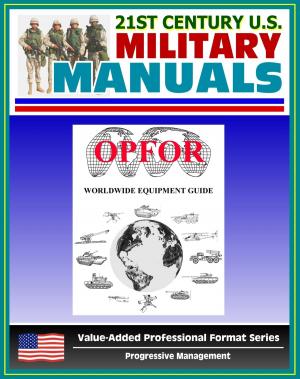Marines in the Korean War Commemorative Series: Drive North - U.S. Marines at the Punchbowl
Nonfiction, History, Asian, Korean War, Military| Author: | Progressive Management | ISBN: | 9781301525638 |
| Publisher: | Progressive Management | Publication: | January 10, 2013 |
| Imprint: | Smashwords Edition | Language: | English |
| Author: | Progressive Management |
| ISBN: | 9781301525638 |
| Publisher: | Progressive Management |
| Publication: | January 10, 2013 |
| Imprint: | Smashwords Edition |
| Language: | English |
This official U.S. Marine Corps history provides unique information about important aspects of the Korean War. Here is an excerpt:
General Thomas arrived in Korea to face an entirely new war. The October 1950 dream of unifying Korea under the sponsorship of the United Nations (U.N.) had swirled away with the Chinese winter intervention. The war still hung in the balance as the United Nations Command attempted to drive the Communist invaders out of the Republic of Korea (ROK) for the second time in less than a year. The U.S. Eighth Army and its Korean counterpart, the Hanguk Gun (South Korean Armed Forces) had rallied in January and February 1951, under the forceful leadership of Lieutenant General Matthew B. Ridgway, USA. United Nations Command had then driven back the Chinese Communist Forces (CCF) and the North Korean People's Army (NKPA). The allies had advanced well north of the 38th Parallel in central and eastern Korea. Goaded by Mao Zedong, General Peng Dehuai ordered his joint expeditionary force of 693,000 Chinese and North Korean soldiers to mount one more grand offensive. Eleven Chinese armies and two North Korean corps (40 divisions) would smash south just west of Hwachon Reservoir in the sectors held by the U.S. I and IX Corps. At a minimum the Communist forces, about half of Peng's total army, would drive United Nations forces below the 38th Parallel. The maximum objective would be to threaten the Han River valley and the corridors to Seoul while at the same time recapturing the territory south of the Soyang River, which opened an alternative corridor south to Hongchon.
When General Thomas called on General Van Fleet on 24 April, the Eighth Army commander, a combative 59-year-old Floridian with a World War II record of successful command from regiment to corps in Europe, felt confident that his forces had blunted the four-day-old Communist offensive. However, he had an organizational problem, which was that the 1st Marine Division should be shifted back to X Corps and redeployed to the No Name Line under the command of Lieutenant General Edward M. Almond, USA, the division's corps commander throughout 1950. The relationship between O. P. Smith and Almond, however, had become so venomous that Ridgway assigned the Marine division to IX Corps in January 1951 and promised Smith that he would not have to cope with Almond, whose style and substance of command angered Smith and his staff. Van Fleet had honored Ridgway's commitment, but the operational situation dictated that the Almond-Smith feud could not take precedence.
Van Fleet explained the plan to shift the 1st Marine Division back to X Corps to Thomas without going into the Almond-Smith problem. Van Fleet did not give Thomas a direct order to proceed immediately to the 1st Marine Division headquarters near Chunchon. Thomas believed, however, that Van Fleet had sound reasons to want a change of command now, so he caught a light plane furnished by the 1st Marine Aircraft Wing and flew to the primitive airstrip that served the division. Escorted by the new assistant division commander, Brigadier General Lewis B. "Chesty" Puller, Thomas went directly to Smith's van and told him of Van Fleet's request and future plans. Smith refused to relinquish command. Without mounting an argument, Thomas left the van and went to the operations center to confer with Colonel Edward W. Snedeker, the chief of staff, and Colonel Alpha L. Bowser, the G-3, both of whom sympathized with Thomas but thought Smith should remain in command. Thomas thought the division was well positioned to refuse the open left flank of X Corps, but he also felt the tension in the command post.
This official U.S. Marine Corps history provides unique information about important aspects of the Korean War. Here is an excerpt:
General Thomas arrived in Korea to face an entirely new war. The October 1950 dream of unifying Korea under the sponsorship of the United Nations (U.N.) had swirled away with the Chinese winter intervention. The war still hung in the balance as the United Nations Command attempted to drive the Communist invaders out of the Republic of Korea (ROK) for the second time in less than a year. The U.S. Eighth Army and its Korean counterpart, the Hanguk Gun (South Korean Armed Forces) had rallied in January and February 1951, under the forceful leadership of Lieutenant General Matthew B. Ridgway, USA. United Nations Command had then driven back the Chinese Communist Forces (CCF) and the North Korean People's Army (NKPA). The allies had advanced well north of the 38th Parallel in central and eastern Korea. Goaded by Mao Zedong, General Peng Dehuai ordered his joint expeditionary force of 693,000 Chinese and North Korean soldiers to mount one more grand offensive. Eleven Chinese armies and two North Korean corps (40 divisions) would smash south just west of Hwachon Reservoir in the sectors held by the U.S. I and IX Corps. At a minimum the Communist forces, about half of Peng's total army, would drive United Nations forces below the 38th Parallel. The maximum objective would be to threaten the Han River valley and the corridors to Seoul while at the same time recapturing the territory south of the Soyang River, which opened an alternative corridor south to Hongchon.
When General Thomas called on General Van Fleet on 24 April, the Eighth Army commander, a combative 59-year-old Floridian with a World War II record of successful command from regiment to corps in Europe, felt confident that his forces had blunted the four-day-old Communist offensive. However, he had an organizational problem, which was that the 1st Marine Division should be shifted back to X Corps and redeployed to the No Name Line under the command of Lieutenant General Edward M. Almond, USA, the division's corps commander throughout 1950. The relationship between O. P. Smith and Almond, however, had become so venomous that Ridgway assigned the Marine division to IX Corps in January 1951 and promised Smith that he would not have to cope with Almond, whose style and substance of command angered Smith and his staff. Van Fleet had honored Ridgway's commitment, but the operational situation dictated that the Almond-Smith feud could not take precedence.
Van Fleet explained the plan to shift the 1st Marine Division back to X Corps to Thomas without going into the Almond-Smith problem. Van Fleet did not give Thomas a direct order to proceed immediately to the 1st Marine Division headquarters near Chunchon. Thomas believed, however, that Van Fleet had sound reasons to want a change of command now, so he caught a light plane furnished by the 1st Marine Aircraft Wing and flew to the primitive airstrip that served the division. Escorted by the new assistant division commander, Brigadier General Lewis B. "Chesty" Puller, Thomas went directly to Smith's van and told him of Van Fleet's request and future plans. Smith refused to relinquish command. Without mounting an argument, Thomas left the van and went to the operations center to confer with Colonel Edward W. Snedeker, the chief of staff, and Colonel Alpha L. Bowser, the G-3, both of whom sympathized with Thomas but thought Smith should remain in command. Thomas thought the division was well positioned to refuse the open left flank of X Corps, but he also felt the tension in the command post.















